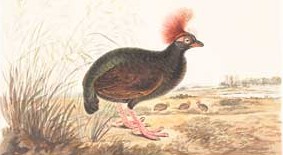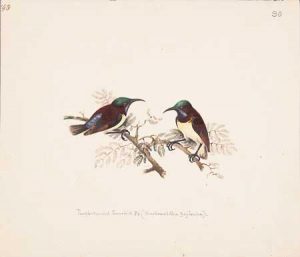
Rare early bird portraits part of Blacker-Wood collection
Some of them look so real they seem ready to take off. But the full-sized portraits of birds by Lady Elizabeth Gwillim were painted more than 200 years ago in Madras, southern India, and for close to a century they have been held in the Blacker-Wood Collection.
The paintings were first discovered at a London art-dealer’s by Casey Wood in 1924. Wood, a retired ophthalmologist with a passion for birds, travelled the world with his wife collecting ornithological and zoological material that he donated to McGill University, his alma mater. But when the dealer told Wood he remembered seeing some old bird paintings in the cellar, Wood had low expectations. “We are all well acquainted with the productions of brush and pencil wielded by ‘ladies of quality’ during the Georgian and early Victorian periods,” Wood wrote dismissively.
But when 10 years of accumulated dust was blown off the covers of “an extremely well made portfolio… five feet broad and four feet high… brass bound with a safety lock and a wide wooden back,” what Wood saw inside astounded him. “The contents amazed and delighted me. I do not claim to be an art expert, but I realized at once that the paintings of Indian birds in the pockets of that giant container were by the hand of no mean draughtsman.”
Life-sized masterpieces
Indeed, a glance at a single one of the 121, mainly life-sized portraits of Indian birds held in the Blacker-Wood

Collection is enough to suggest that Elizabeth Gwillim was very patient, extremely observant, and above all, a very talented painter. Canadian artist and ornithologist Terence Michael Shortt judged her bird portraits to be among “the finest ever done of Asian birds.” He praised Gwillim’s skill in depicting both large birds such as vultures and storks and smaller birds like the Indian thrushes, where her portraits “capture the saucy, perky attitudes of these creatures in a way [that no one else did until] a full century later.”
“I’ve learned a fair bit about her over the years,” says Eleanor MacLean, the recently retired librarian who has spent the last 35 years looking after the Blacker-Wood Collection. “They were done from life – that’s one of the amazing things about them. The work is excellent and some of them have great backgrounds.”
The daughter of a moderately successful stonemason and architect (her father was fired from his work on the Hereford Cathedral when the tower he was propping up collapsed), Elizabeth Symonds was born in Hereford in April 1763. It is not known how or when she started painting, though the pastime was popular among the English middle classes of the period. When she was 17 or 18, Elizabeth met and married barrister Henry Gwillim, who, some 15 years later, was knighted and appointed to the High Court in Madras. So Elizabeth and her husband, along with her sister Mary Symonds, who had hopes of finding a husband there, set sail for India in 1801.
When they arrived in Madras, the sisters were quickly caught up in the social whirl, which they very much enjoyed early on. In letters home they wrote, “There is a vast deal of visiting in this place which is very pleasant when one is quite at leisure.” But they also complained of a lack of privacy and as time passed the family spent more and more of their time in their residence at some distance from the city itself.

This pulling back from social commitments gave Elizabeth and Mary, some of whose paintings of fish and flowers are also in the Blacker-Wood collection, more time to explore the beautiful natural world they set out to capture. As well as being interested in the birds she saw around her, Elizabeth was also fascinated by the plants, animals and buildings of southern India. In the less than six years she spent in India, Elizabeth produced some 200 works.
Elizabeth Gwillim died on December 21, 1807, at the age of 44, of unknown causes. She is buried in St. Mary’s Church in Fort. St. George, Madras. Her paintings presumably travelled back to England with Sir Henry Gwillim who left shortly thereafter.
The Elizabeth Gwillim paintings have been digitized and will eventually be available online. For the time being they are available for viewing in the Rare Books and Special Collections Reading Room, by appointment only. Contact 514-398-4711 or Rarebooks.library@mcgill.ca
